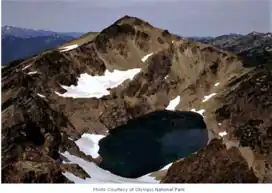| Mount Claywood | |
|---|---|
 Southeast aspect, from Mt. Fromme | |
| Highest point | |
| Elevation | 6,836 ft (2,084 m)[1] |
| Prominence | 1,236 ft (377 m)[1] |
| Parent peak | Mount Cameron (7,190 ft)[2] |
| Isolation | 2.41 mi (3.88 km)[2] |
| Coordinates | 47°48′03″N 123°22′13″W / 47.800897°N 123.370413°W[1] |
| Naming | |
| Etymology | Henry Clay Wood |
| Geography | |
 Mount Claywood Location of Mount Claywood in Washington  Mount Claywood Mount Claywood (the United States) | |
| Location | Olympic National Park Jefferson County, Washington, US |
| Parent range | Olympic Mountains |
| Topo map | USGS Wellesley Peak |
| Geology | |
| Age of rock | Eocene |
| Climbing | |
| Easiest route | class 2 hiking via Hayden Pass Trail[3][2] |
Mount Claywood is a 6,836-foot (2,084-metre) mountain summit located within Olympic National Park in Jefferson County of Washington state.[4] It is situated at the head of Lost River, and 15 mi (24 km) east of Mount Olympus. Its nearest higher neighbor is Mount Cameron, 2.4 mi (3.9 km) to the northeast.[1] Other nearby peaks include Mt. Fromme, 0.58 mi (0.93 km) to the southeast, and Sentinel Peak, 2 mi (3.2 km) also to the southeast. Precipitation runoff from the mountain drains north and west into tributaries of the Elwha River, and east into Claywood Lake, thence Dosewallips River.
History
_2.jpg.webp)
This mountain was originally named "Mount Clay Wood" in 1885 by Lieutenant Joseph P. O'Neil to honor his superior, Colonel Henry Clay Wood (1832–1918), Assistant Adjutant General, Department of the Columbia, who signed the orders for O'Neil's 1885 exploration of the Olympic Mountains.[4][5] Mt. Claywood marks the expedition's deepest penetration from the north into the Olympic wilderness.[5]
Climate
Based on the Köppen climate classification, Mount Claywood is located in the marine west coast climate zone of western North America.[6] Most weather fronts originate in the Pacific Ocean, and travel northeast toward the Olympic Mountains. As fronts approach, they are forced upward by the peaks of the Olympic Range, causing them to drop their moisture in the form of rain or snowfall (Orographic lift). As a result, the Olympics experience high precipitation, especially during the winter months. During winter months, weather is usually cloudy, but due to high pressure systems over the Pacific Ocean that intensify during summer months, there is often little or no cloud cover during the summer. The months July through September offer the most favorable weather for viewing or climbing this peak.
Geology
The Olympic Mountains are composed of obducted clastic wedge material and oceanic crust, primarily Eocene sandstone, turbidite, and basaltic oceanic crust.[7] The mountains were sculpted during the Pleistocene era by erosion and glaciers advancing and retreating multiple times.
See also
References
- 1 2 3 4 "Mount Claywood". Peakbagger.com.
- 1 2 3 "Claywood, Mount - 6,836' WA". listsofjohn.com. Retrieved 2020-08-26.
- ↑ Mount Claywood climbersguideolympics.com
- 1 2 "Mount Claywood". Geographic Names Information System. United States Geological Survey, United States Department of the Interior. Retrieved 2020-08-26.
- 1 2 Parratt, Smitty (1984). Gods and Goblins: A Field Guide to Place Names of Olympic National Park (1st ed.).
- ↑ Peel, M. C.; Finlayson, B. L.; McMahon, T. A. (2007). "Updated world map of the Köppen−Geiger climate classification". Hydrol. Earth Syst. Sci. 11: 1633–1644. ISSN 1027-5606.
- ↑ Alt, D.D.; Hyndman, D.W. (1984). Roadside Geology of Washington. pp. 249–259. ISBN 0-87842-160-2.
External links
- "Olympic National Park". National Park Service.
- Weather forecast: Mount Claywood
- Mount Claywood: Flickr photo